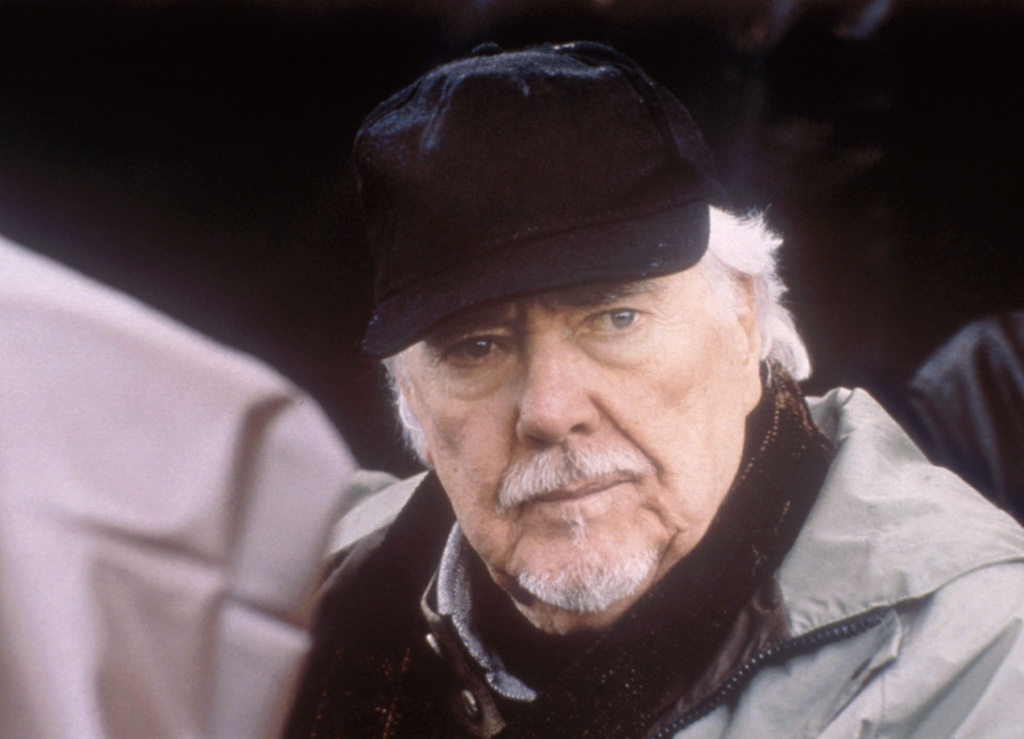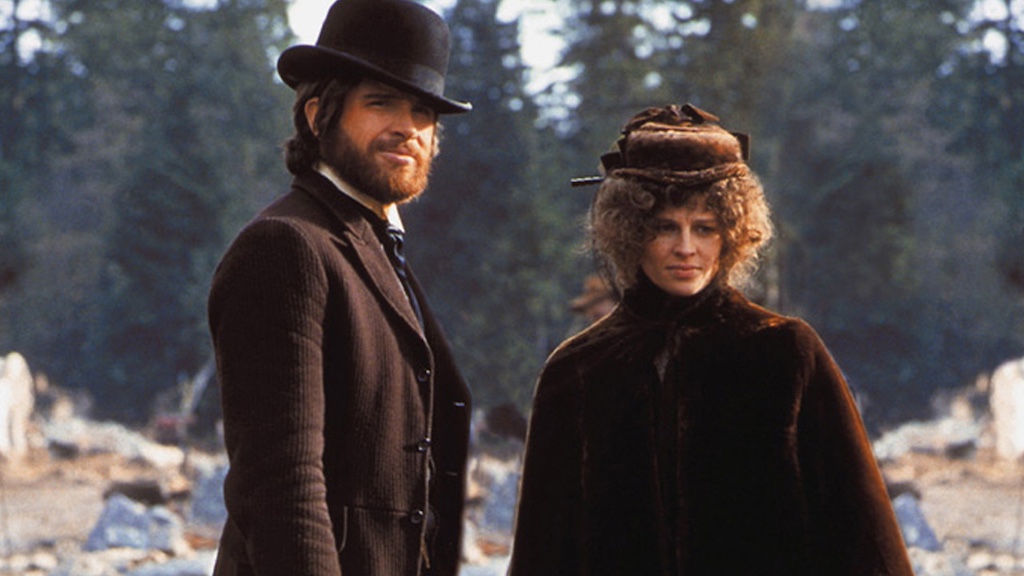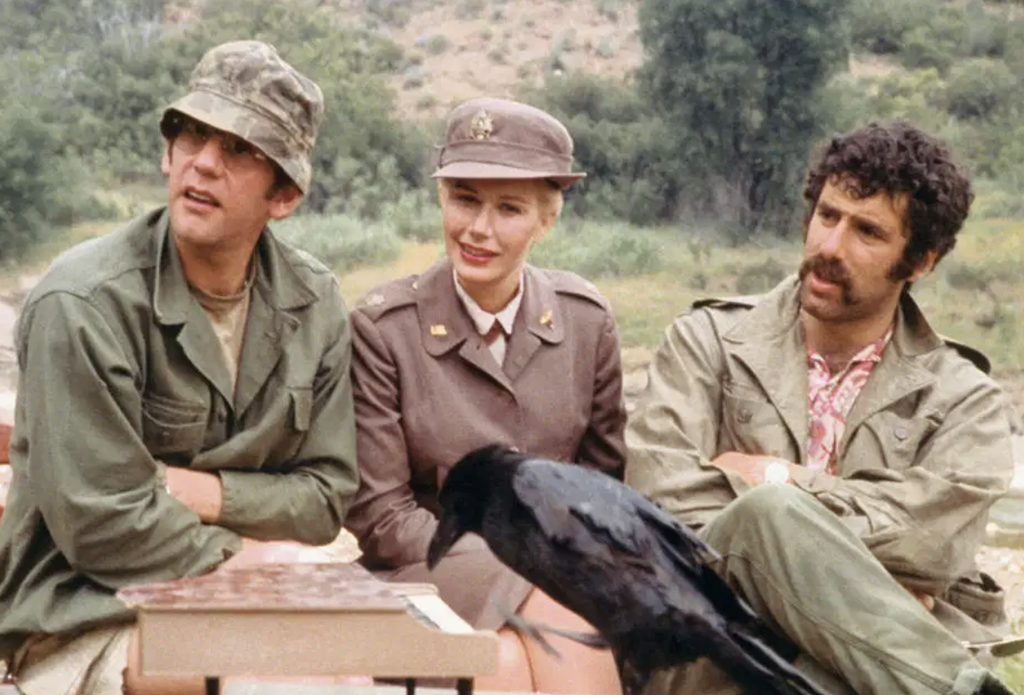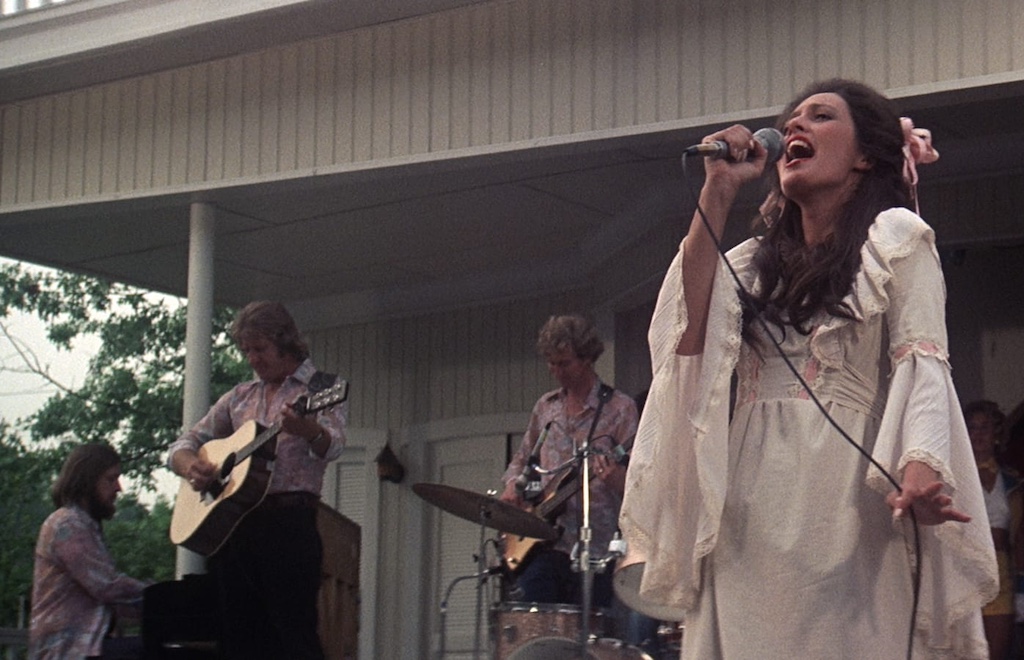Hollywood Could Use Another Robert Altman Right Now
The Criterion Channel’s retrospective on Robert Altman, the auteur behind masterpieces like Nashville, M*A*S*H, and The Long Goodbye, is a reminder that, not long ago, Hollywood backed maverick filmmakers ready to shake up the medium and the culture at large.

Robert Altman on the set of Gosford Park (2001). (Chicagofilms / Getty Images)
In celebration of what would have been his hundredth birthday, the Criterion Channel is currently featuring an extensive series of films by maverick auteur Robert Altman, who became so renowned in the 1970s that the term “Altmanesque” got bandied about regularly among critics and cinephiles. According to The Big Picture’s Sean Fennessey, whose video essay on Altman accompanies the Criterion series, “Altmanesque” refers to “the subversion of all expected modes in narrative storytelling — in genre, in filmmaking style, in performance.”
And for a director with a tendency toward “the undoing of everything we expect from a Hollywood movie,” Altman had an incredibly robust Hollywood career. His idiosyncratic approach to filmmaking treated the script as a “diagram” that provided loose guidelines but need not be adhered to while going through the process of “actors finding character and story finding itself.” In keeping with an approach that was virtually designed to oppose classical Hollywood production practices and drive producers and studio executives crazy, he favored intensive collaboration with actors.
Altman loved actors, and they almost uniformly adored him. He not only recruited great talent for film, such as Shelley Duvall, Lily Tomlin, and almost the entire supporting cast of M*A*S*H, whom he drafted from the American Conservatory Theater (ACT) in San Francisco, but also guided such favorites as Duvall and Elliott Gould to repeated flights of idiosyncratic brilliance.
Even in the rare case that an actor hated Altman’s process — well-known control freak Warren Beatty playing the glib but ultimately hapless and doomed frontier entrepreneur McCabe in McCabe & Mrs. Miller is the most famous example — that actor tended to give a career-best performance under Altman’s direction. Beatty’s then-girlfriend Julie Christie only got the part of Mrs Miller, the hard-bitten Cockney madam of a frontier brothel, because Beatty insisted on it as part of his own deal. Together, she and Altman cocreated an earthy, gritty character of hair-raising power and stealthy vulnerability, and she “was totally enamored of him,” as Beatty resentfully put it years later.

Altman was constantly forced to fight for creative control with humorless Hollywood “money men.” His socio-politically charged 1970s landmark films like M*A*S*H and Nashville kicked off a long career of undermining the American mythos in increasingly lively ways, including skewed takes on film genres such as the Western (McCabe & Mrs. Miller, Buffalo Bill and the Indians, or Sitting Bull’s History Lesson) and detective-centered film noir (The Long Goodbye).
Falling completely out of favor in the back-to-business 1980s after Popeye flopped, he returned to television and started directing plays. It was during this time that he directed Secret Honor (1984), an adaptation of a one-man play by Donald Freed and Arnold M. Stone filmed in a room at the University of Michigan. Typical of his work during the Ronald Reagan years, Secret Honor stars Philip Baker Hall as Tricky Dick, ranting and raving in an extended monologue about the forces who took him down, and it ends with Richard Nixon, holding a loaded pistol, screaming “Fuck ’em!” in a seemingly infinite loop. Altman’s film career recovered in the 1990s with his Hollywood satire The Player, and he had a final hit with Gosford Park (2001), a fierce critique of the British class system.
Because of his big breakthrough critically and commercially with M*A*S*H in 1970, and the gusher of major production financing that spewed forth, Altman is often lumped together with the other young New Hollywood filmmakers who rose swiftly to the top during the troubled Hollywood era of the 1960s and ’70s. Fellow auteurs such as Francis Ford Coppola, Martin Scorsese, Hal Ashby, and Bob Rafelson were given the keys to the kingdom out of sheer desperation on the part of studio suits who had lost touch with what mass audiences wanted and hoped young directors might at least retain the college kids as regular moviegoers.
But Fennessey argues that Altman is really more properly placed among daring, iconoclastic directors who also did hard time in the world of 1950s through early 1960s television directing before making the leap into feature filmmaking: Sam Peckinpah (Ride the High Country, The Wild Bunch, Straw Dogs) and John Frankenheimer (Birdman of Alcatraz, The Manchurian Candidate, Seconds). Altman was considerably older than those generally considered to be his peers. He was already forty-five when he finally made it to the top in features and he’d lived an edgy, action-packed life that set him up nicely to succeed in the American entertainment industry.
He was the son of prominent, affluent people in Kansas City, Missouri: a Mayflower descendent beloved in the community, Helen Matthews, and a top insurance salesman, Bernard Clement “B. C.” Altman. B. C. had charming grifter tendencies and reputedly could convince anyone to do anything, including buying ever more insurance from him whenever his gambling debts got too excessive. Tall, handsome, and much admired among the local girls, young Robert Altman grew up inheriting his father’s persuasive charms and gambler’s tendencies.
Fate took a hand in dictating his future. America was well into World War II by the time Altman came of age, and rather than wait to be drafted, Altman enlisted in the US Army Air Force and became a decorated pilot in the Pacific Theater. He flew an astounding fifty bombing missions, with his statistically calculated life expectancy shrinking drastically after thirty missions. Somehow, he emerged physically unscathed — despite screaming nightmares that terrorized his family for months after his return to civilian life — while many other pilots, bombardiers, gunners, and other crew members in his squadron died or were badly wounded. A friend commented that such a brutal experience of war prepared Altman to deal fearlessly with the sharks of show business: “After he’d survived all that, what were they going to do to him?”
After the war, Altman learned his trade as a writer-director making industrial and educational films at the Calvin Company in his hometown of Kansas City, Missouri, where the Altman family were prominent, affluent citizens. But, as a young movie-lover, he’d set his sights on Hollywood long before. It was after he saw David Lean’s emotionally devastating romantic tragedy Brief Encounter (1945) that Altman became obsessed with trying to understand the transformative power of acting and directing. He began watching the film, he reported, finding the female lead played by Celia Johnson not at all attractive, a staid “sensible shoes” kind of woman, but before he knew it, by some amazing alchemy, “I was in love with her.”
After several false starts in Hollywood, and embarrassing returns to Kansas City to earn some more money at the Calvin Company, Altman finally got some traction in television, shooting episodes for innumerable shows such as Alfred Hitchcock Presents, Bonanza, Kraft Mystery Theatre, Hawaiian Eye, Maverick, Peter Gunn, and Route 66. He became a much-admired TV director, readily identified as among the best in the business, though he resented the rigidity and relentless pace of TV production, which forced him into a jaded familiarity with the workings of genre narratives.
After ten years, when he finally got his shot at feature filmmaking, Altman’s used that familiarity as a springboard into, as Fennessey puts it, using genres as “a platform to figure out how to tell stories . . . to understand archetype and expectation around storytelling. But that doesn’t mean you have to have that same three-act structure and that same rising action to a climax and moment of doubt for all his protagonists.”
Finally, by the end of the 1960s, American audiences were ready to aid and abet Altman’s longing to subvert genre narratives, and the result is 1970’s M*A*S*H. Superficially, it’s a mess of a movie, deliberately deconstructed, so loose-jointed in its episodic structure and multistrand narrative vignettes that it barely seems to hang together. Though, in fact, it has a strong narrative spine just below the surface.

Ostensibly set during the Korean War — but shorn of any period-appropriate costumes or hairstyles — it starts with the arrival of Army surgeons “Hawkeye” Pierce (Donald Sutherland) and “Duke” Forrest (Tom Skerritt), joined a little later by “Trapper John” MacIntyre (Elliott Gould). Their insidiously anarchic tendencies gradually overwhelm the rote militarism, jingoistic patriotism, and religiosity of the personnel and command structure, transforming the unit’s approach to the bloody madness of the war with a kind of life-affirming inoculation in the form of a willfully humorous madness. Once the conversion is complete, Hawkeye and Duke are mustered out and go home.
It’s heartwarming and ironic to note that strongly leftist screenwriter Ring Lardner Jr (The Cincinnati Kid, Laura), who was blacklisted as a member of the Hollywood Ten back in 1947, won an Oscar for his adaptation of the autobiographical novel MASH: A Novel About Three Army Doctors by Richard Hooker. (Lardner Jr later admitted that Altman should’ve gotten cowriter credit because so much of the script was changed in Altman’s typically collaborative production process.) Hooker based the book on his own experiences as a Korean War surgeon, but as Altman always said, the film was both intended to be and generally received as a satire of the sickening lunacy of the Vietnam War.
Lead actors Sutherland and Gould were initially so alarmed by Altman’s idiosyncratic approach to directing, they tried to have him fired. Given the eccentricities of those two quintessential counterculture actors, it’s a good indication of how outlandish Altman’s approach must have seemed at the time. Famously, Altman saw himself as the opposite of the director-as-autocrat figure enshrined in the studio system, instead identifying as, ideally, a kind of “party host,” fostering a collaborative experience for the cast and crew as well as for audiences in theaters.
Altman’s stylistic approach to filmmaking was startling to many cast and crew members who’d never seen anything like it. Actors in M*A*S*H cautioned each other to stay on their toes and come up with plenty of in-character bits of business, because Altman favored microphones everywhere and a “floating camera” technique that allowed him surveillance over everyone within a crowded scene, from the lead actors down to the extras. His signature camera move, the slow zoom-in, would isolate a suddenly pinpointed character for psychologically revealing moments.
And Altman’s famous overlapping sound — a bid for greater realism, which he always said was inspired by director Howard Hawks’s pioneering way of handling fast-paced dialogue in films like His Girl Friday (1940) — was nevertheless still regarded as so transgressive of “professional” sound recording and mixing standards, it got him fired from an early film assignment by Jack Warner himself. Beatty had a notorious public freak-out at an advance screening of McCabe & Mrs. Miller over the deliberate confusion of background and foreground dialogue. He confronted Altman in the theater balcony to exclaim, as Beatty put it, “‘I can’t hear’ — I might have said ‘a fucking word . . . in the first or second reel.’”
Considering Altman’s long hard apprenticeship in television followed by his blazing start in film, it makes you wonder: has any other director had such a concentrated burst of protean creativity as Altman did in the early 1970s? Perhaps Preston Sturges in the early 1940s, but it’s certainly a rare thing to see one remarkably inventive film after another pumped out at the rate Altman was making them. Here’s the rundown of his greatest years: M*A*S*H (1970), Brewster McCloud (1970), McCabe & Mrs. Miller (1971), Images (1972), The Long Goodbye (1973), California Split (1974), Thieves Like Us (1974), and Nashville (1975). I don’t even particularly love Altman’s films, and I’d say there are, arguably, at least three masterpieces in there.

And it’s worth revisiting M*A*S*H, the film that transformed Altman’s life and career, both for what’s exciting about his breakthrough and what’s a bit shocking in a contemporary context. The horndog humanism animating the anarchic hijinks of the three merry-prankster surgeons at the center of the film got complaints even at the time for its sexism, and today it can’t help but play as misogynistic and bullying, with some intensive homophobia along with it.
Sally Kellerman, playing dedicated nurse Major “Hot Lips” Houlihan, argued that her character, in being repeatedly humiliated by the surgeons’ pranks — including a scene in which the canvas covering of the women’s showers is pulled away in order to settle a bet about the color of her pubic hair — was actually liberated from her rigid approach to military service to enjoy the atmosphere of laughs and free love in the MASH unit. But it’s hard to view it that way now, especially when she’s relegated in the end to a member of the mindlessly rooting cheerleading squad along with the other nurses during the crazy, climatic Marx Brothers–like football game.
Altman always argued that he was targeting the “puerile” tendencies of army men, represented by the sexist prankster surgeons, along with excoriating knee-jerk militarism, in a tough-minded all-encompassing satire. And to his credit, he always announced his hatred of the long-running television show that softened all the rough edges of his creation and filled it with bland liberal bromides.
Nevertheless, it’s hard not to read the film in terms of its celebration of the “general air of mischief and anarchy” promoted by the surgeons. These qualities are, as Fennessey puts it, basic to Altman’s approach to film and currently “missing from American cinema” in a way that “resonates in our political and social culture right now.”
That’s the wistful experience of looking back at so many Altman films — their lively inventiveness and fearless satirical humor reflect so badly on our cinematically timid times. Even while likely targets of a subversive Altmanesque approach loom larger than ever in our politically monstrous era, there’s a critical shortage of directorial talent ready to take them on.